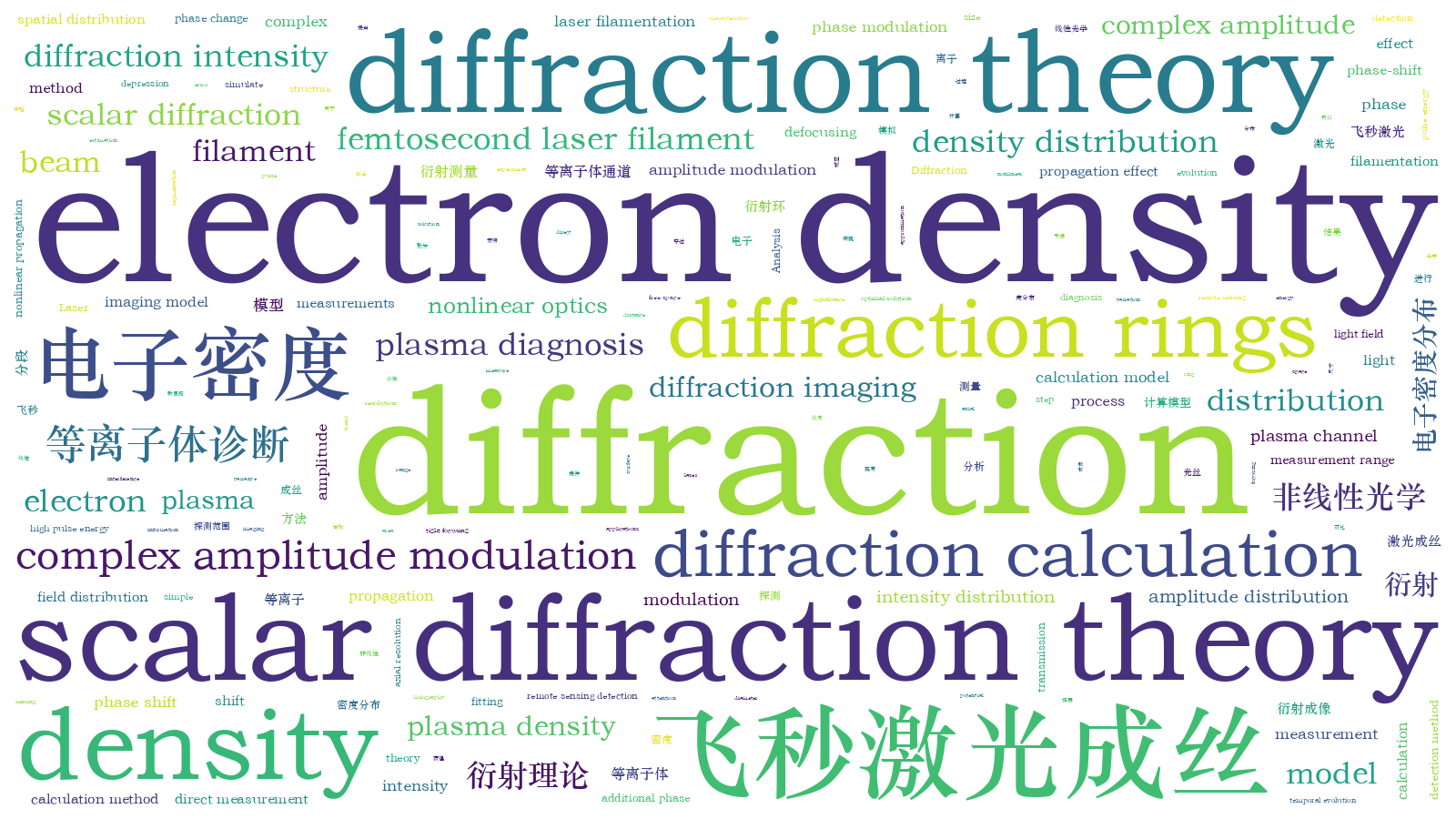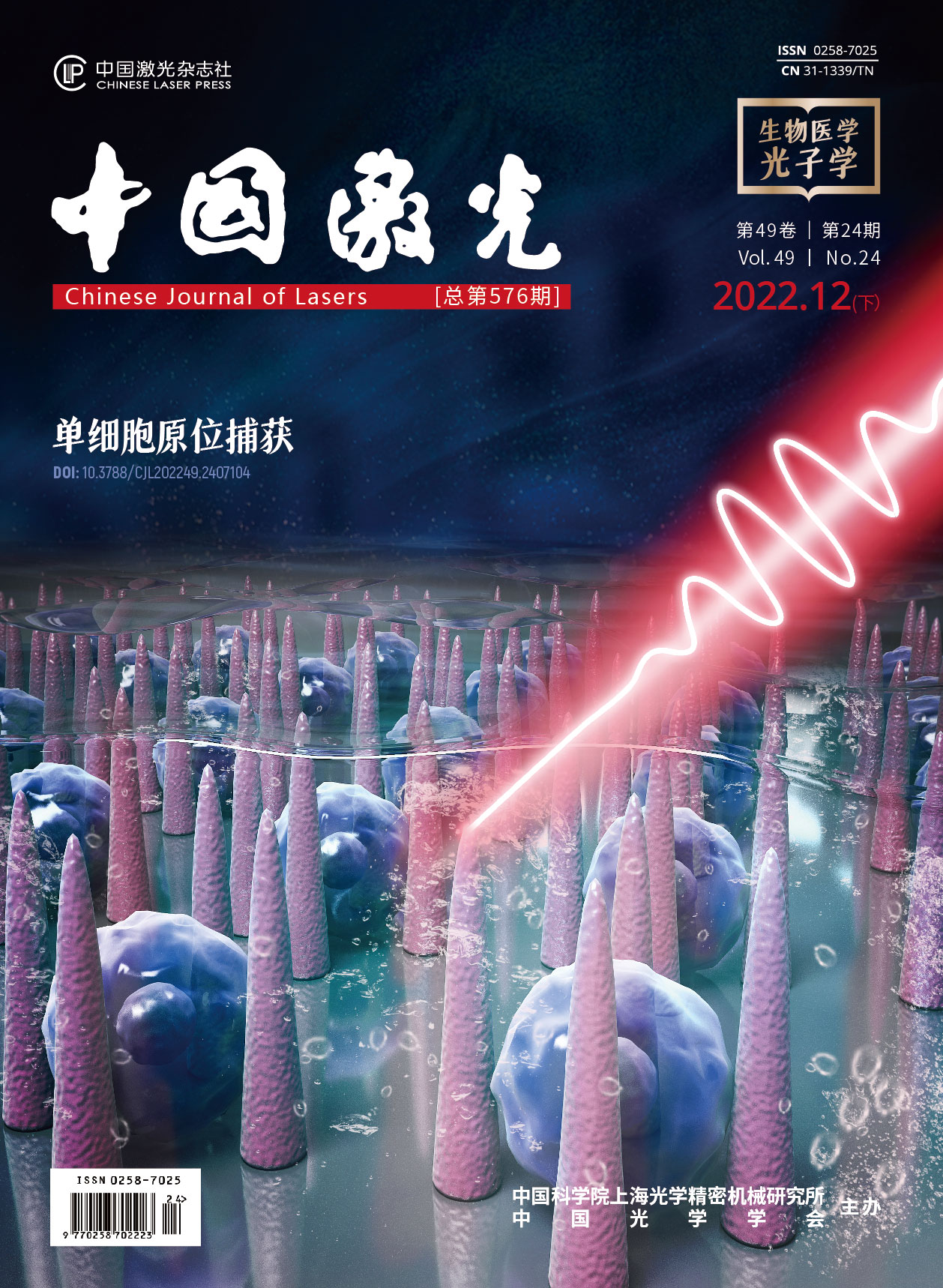飞秒激光成丝的衍射分析方法  下载: 716次
下载: 716次
Femtosecond laser filamentation has garnered significant attention and shown great potential in guiding discharge and remote sensing detection owing to its unique characteristics. The measurement of the size and internal electron density of a filament is of great significance for understanding the nonlinear propagation and evolution law of a filament and for developing various applications. Electron density measurements in a filament can be divided into two categories: direct measurement detection method such as electrical measurement and measurement of the density by interference, diffraction, and holography. The experimental setup of the longitudinal diffraction method is relatively simple, and the temporal evolution of plasma density can be recorded at the expense of axial resolution information. However, the diffraction propagation models of probe beam based on the longitudinal diffraction method in previous studies ignored the modulation of the probe beam intensity affected by plasma defocusing. Modulation from the plasma defocusing effect cannot be ignored when the plasma density is high. In this study, a segmented diffraction imaging model based on scalar diffraction theory is established to accurately simulate the diffraction transmission process of a probe beam.
Scalar diffraction theory effectively describes the propagation of light in free space and is a reasonable approximation of the propagation effect of light. In this work, a plasma channel was divided equally into N segments; the length of each segment was Δd=Lfil/N, and the complex amplitude distribution of the probe beam at the entrance of the filament (z=z0) was U0=exp(-ar2). The defocusing modulation experienced by the probe beam in each section was regarded only as a phase change. The calculation process is illustrated in Figure 2. First, the diffraction transmission result of the probe beam at a distance was calculated using equation (1). Second, the result of the first step was multiplied by the phase shift caused by this section of the filament. The result of the second step was the final light-field distribution in this section and the complex amplitude distribution of the initial plane of the next transmission process. Finally, the first and second steps were repeated N times, and the complex amplitude distribution at the exit of the filament was obtained. A comparison was made between the segmented diffraction model and previous models.
The structure of the diffraction ring changes correspondingly with changes in ne0 and w. The intensity of higher-order diffraction rings and the number of diffraction rings increase with an increase in the electron density. The modulation of the central region is enhanced, and the intensity of the high-order diffraction rings is weakened with an increase in the filament radius. Additionally, the radius of the diffraction rings always increases with an increase in ne0 and w. Under the conditions of high pulse energy and tight focusing, the early high-density plasma channel shows strong diffraction modulation for the probe beam [Figure 4(a1)]. The SSE logarithmic surfaces with N=25 and N=10 produce a significant depression area, and the minimum values in the depression are obtained at (ne0, 2w)=(8.8×1017 cm-3, 90 μm) using the segmented diffraction model. The corresponding fitting results are shown in Figure 4 (e1). The plasma defocusing effect is only reflected in the additional phase shift, and the optimal solution corresponding to the minimum value of the SSE is (ne0, 2w)=(2.1×1018 cm-3, 90 μm) with the number of segments N=0. The SSE value of segment N=0 is larger than that based on the segment diffraction model. This indicates that the corresponding fitting effect of segments N=0 is worse than that of the segmented model. The surface obtained without segmentation does not produce a prominent concave region; therefore, the minimum value is insignificant and the corresponding electron density distribution is not accurate and reliable. The probe beam is only subject to a change in the phase shift, and the diffraction intensity distribution deviates greatly from the actual situation. It is difficult to accurately measure the electron density and diameter of a filament with a relatively high electron density. The SSE value of segments N=0 is also larger than the result based on the segment diffraction model under the relatively low electron density condition [Figure 4(e2)]. The measurement results of the two models are similar, and both fit the experimental results well when the electron density drops to approximately 1×1017 cm-3. The plasma channel is assumed to have a cylindrical symmetric electron density distribution. The modulation effect of the probe beam passing through the plasma channel is not a simple phase modulation but a complex amplitude modulation. The consideration of directly adding a phase-shift model to this modulation process is imperfect. The segmented diffraction calculation reflects the process by which the complex amplitude of the light field is modulated as a whole. The segmented calculation simulates the distribution of the complex amplitude of the modulated probe beam with a smaller fitting error. Correspondingly, the radial spatial distribution of the electron density of the filament can be obtained more accurately. The radial intensity distribution of the experimental curve is relatively stable. The radial intensity variation trend of the diffraction structure fitted according to the minimum value of the sum variance SSE is consistent with the experimental results. The calculation method based on subsection diffraction is reasonable and reliable for the diagnosis and estimation of electron density distribution.
A piecewise diffraction calculation model based on scalar diffraction theory was proposed to simulate the propagation of probe beam in the same direction as the filament. Based on this model, the diffraction rings of the detected light recorded in the experiment were fitted. The results show that the segmented diffraction model can extend the measurement range for higher electron densities. The measurements of the electron density and filament size based on the segmented diffraction model provide a new analysis method for the precise diagnosis of filaments.
郑恒毅, 尹富康, 王铁军, 刘尧香, 魏迎霞, 朱斌, 周凯南, 冷雨欣. 飞秒激光成丝的衍射分析方法[J]. 中国激光, 2022, 49(24): 2408001. Hengyi Zheng, Fukang Yin, Tiejun Wang, Yaoxiang Liu, Yingxia Wei, Bin Zhu, Kainan Zhou, Yuxin Leng. Diffraction Analysis of Femtosecond Laser Filaments[J]. Chinese Journal of Lasers, 2022, 49(24): 2408001.







